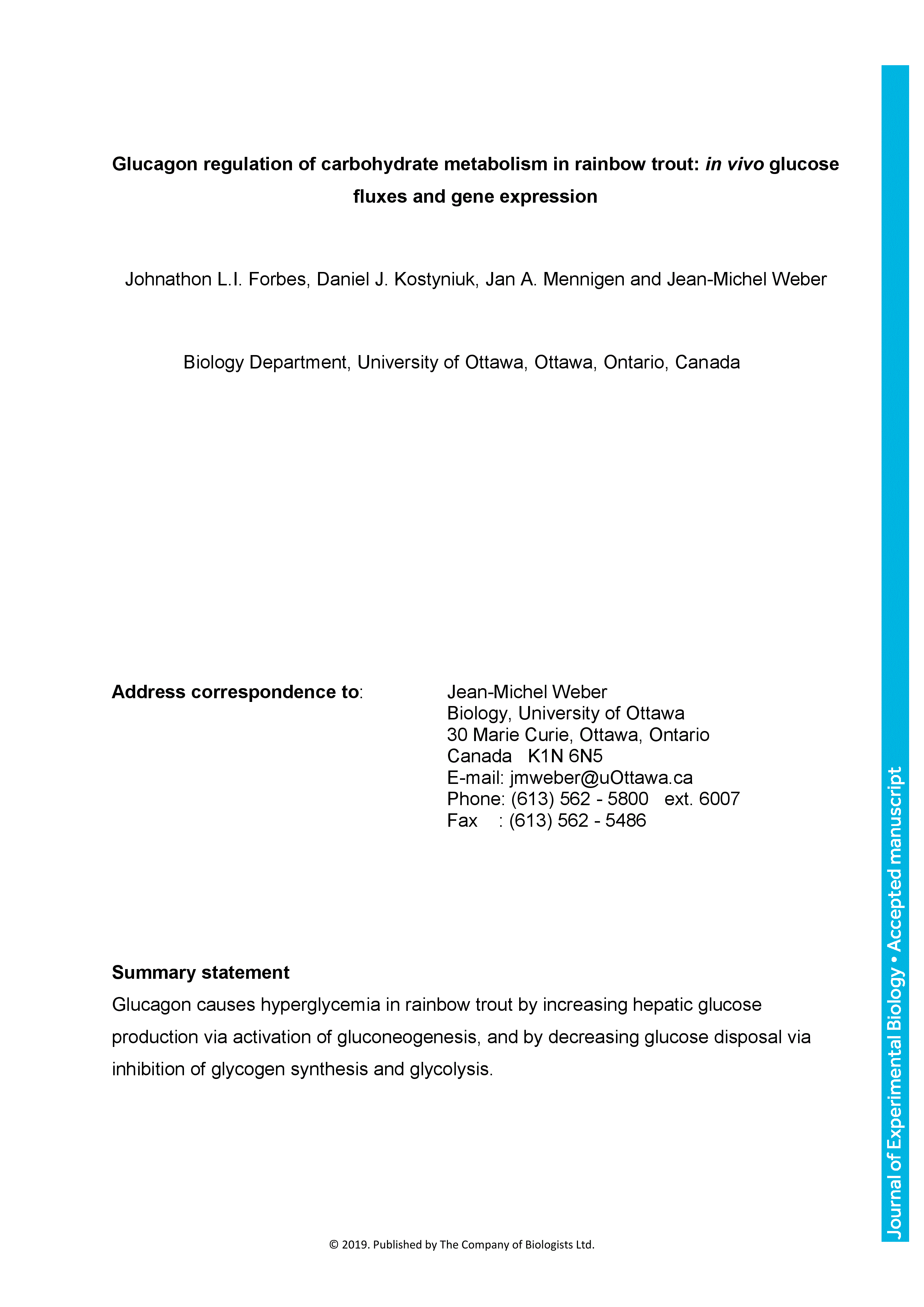Glucagon increases fish glycemia, but how it affects glucose fluxes in vivo has never been characterized. The goal of this study was to test the hypothesis that glucagon stimulates hepatic glucose production (Ra) and inhibits disposal (Rd) of rainbow trout. Changes in the mRNA abundance of key proteins involved in glycolysis, gluconeogenesis, and glycogen breakdown were also monitored. Results show that glucagon increases glycemia (+38%) by causing a temporary mismatch between Ra and Rd before both fluxes converge below baseline (-17%). A novel aspect of the regulation of trout gluconeogenesis is also demonstrated: the completely different effects of glucagon on the expression of three Pepck isoforms (stimulation of pck1, inhibition of pck2a, and no response of pck2b). Glycogen phosphorylase was modulated differently among tissues, and muscle upregulated pygb and downregulated pygm. Glucagon failed to activate the cAMP-dependent protein kinase or FoxO1 signalling cascades. We conclude that trout hyperglycemia results from the combination of two responses: (i) an increase in Ra glucose induced by the stimulation of gluconeogenesis through transcriptional activation of pck1 (and possibly glycogen phosphorylase), and (ii) a decrease in Rd glucose via inhibition of glycogen synthase and glycolysis. The observed decrease in glucose fluxes after 4 h of glucagon administration may be caused by a counterregulatory response of insulin, potentially linked to the decrease in pygm transcript abundance. Overall, however, these integrated effects of glucagon only lead to modest changes in glucose fluxes that partly explain why trout seem to be unable to control glycemia very tightly.
Glucagon regulation of carbohydrate metabolism in rainbow trout: in vivo glucose fluxes and gene expression
Currently Viewing Accepted Manuscript - Newer Version Available
Johnathon L. I. Forbes, Daniel J. Kostyniuk, Jan A. Mennigen, Jean-Michel Weber; Glucagon regulation of carbohydrate metabolism in rainbow trout: in vivo glucose fluxes and gene expression. J Exp Biol 2019; jeb.211730. doi: https://doi.org/10.1242/jeb.211730
Download citation file:
Advertisement
2023 JEB Outstanding Paper Prize shortlist and winner

The JEB Editors are delighted to announce the shortlisted authors for the 2023 JEB Outstanding Paper Prize. Read the winning paper - Tiny spies: mosquito antennae are sensitive sensors for eavesdropping on frog calls - by Hoover Pantoja-Sanchez and Brian Leavell from Ximena Bernal's lab at Purdue University, USA.
JEB Science Communication Workshop for ECRs

If you’re an early-career researcher interested in science communication and are attending the SEB Annual Conference in Prague this summer, come a day early and join the JEB Editors at a sci comm workshop to learn the key writing skills needed to promote your research to a broad audience beyond your peers (1 July at 14.30-17.30). Places are limited to 24 attendees, and applicants should apply through the SEB registration page by 30 April 2024.
Bridging the gap between controlled conditions and natural habitats in understanding behaviour

Novel technologies enable behavioural experiments with non-model species, in naturalistic habitats and with underexplored behaviours. In their Commentary, Scholz and colleagues discuss how to obtain a deeper understanding of the natural ecology and lifestyle of study animals.
Beluga metabolic measures could help save species

To help save animals from extinction, it’s important to understand what each species needs to survive. This led Jason John et al. to measure the metabolic rates of captive belugas to develop a ‘fish calculator’ showing that the whales need to eat ~23 salmon per day.
ECR Workshop on Positive Peer Review

Are you an ECR looking for tips on how to write concise, astute and useful manuscript reviews? If so, join the JEB Editors at a 2-hour JEB-sponsored Workshop on Positive Peer Review at the Canadian Society of Zoologists annual meeting in Moncton on 9 May 2024 at 13.00-15.00. There are 25 spaces for ECRs and selection is first come, first serve. To sign up, check the ECR Workshop box when you register for the CSZ meeting.



